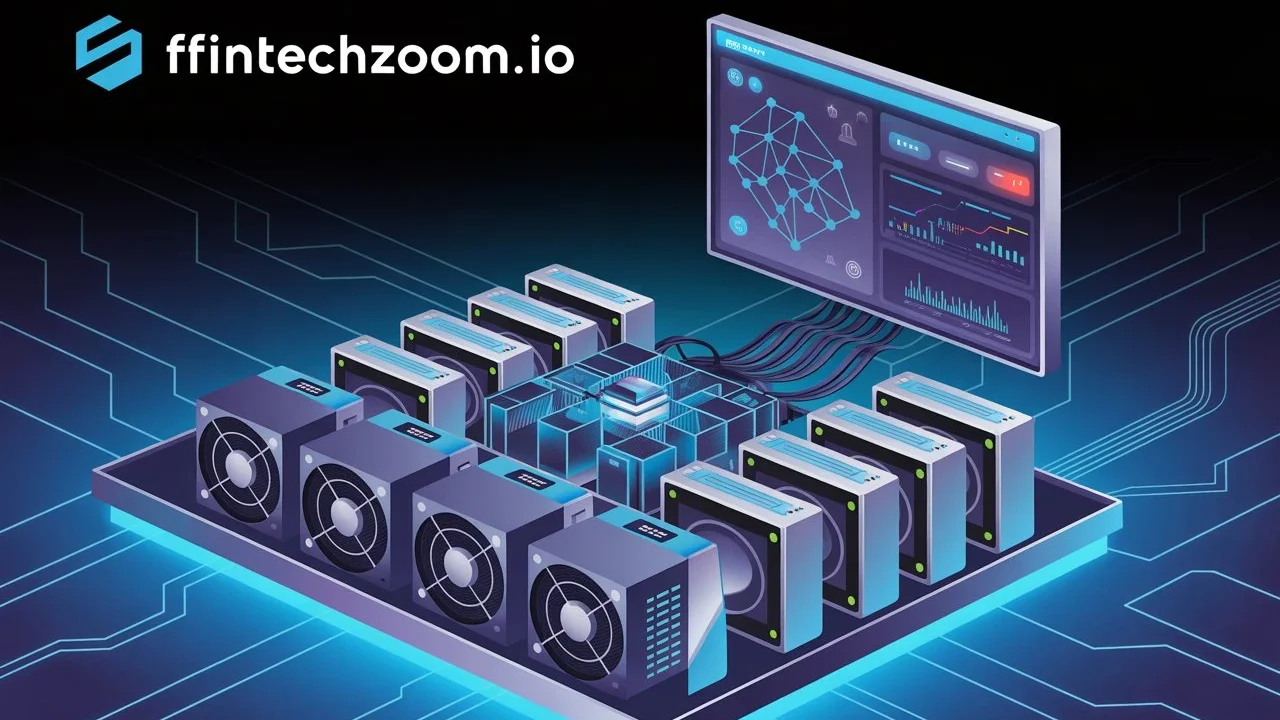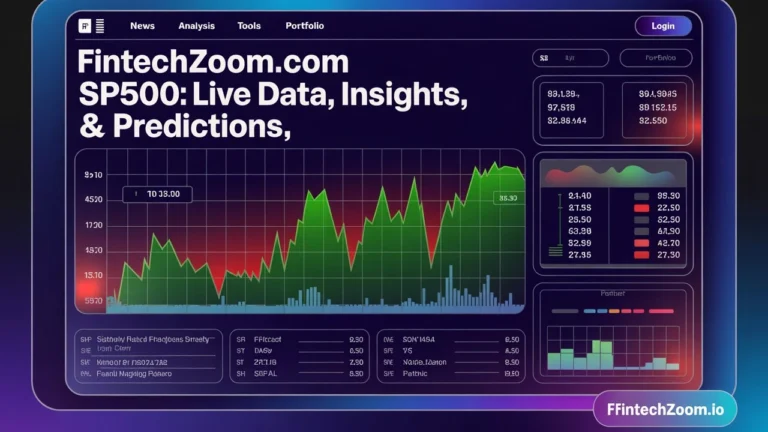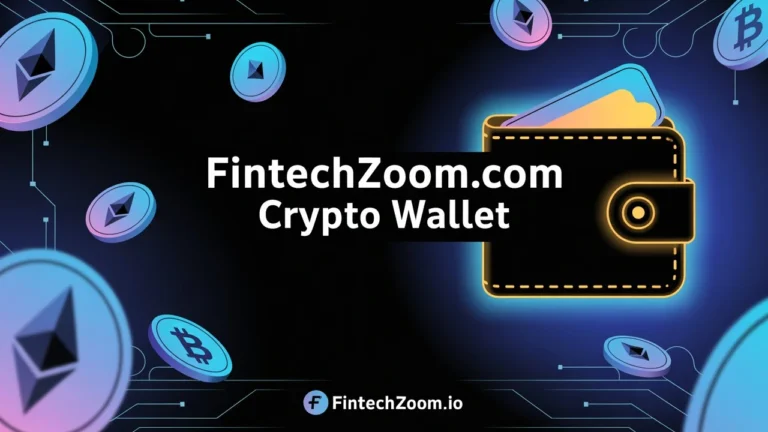Fintechzoom.com Crypto Mining | Simple, Smart & Profitable

Crypto mining used to sound like something only tech wizards or giant companies could do. In 2025, that’s no longer true. Today, even regular people can take part, thanks to tools and insights from platforms like Fintechzoom.com.
If you’ve come across the phrase Fintechzoom.com crypto mining and felt confused, you’re not alone. But don’t worry—it’s easier to understand than you might think. At its core, crypto mining means using powerful computers to help run digital money systems like Bitcoin or Litecoin. In return, miners get rewarded with coins.
What’s changing now is how people mine. It’s not just about having the fastest computer anymore. It’s about using the right tools, staying up to date, and choosing the smartest path forward. That’s where Fintechzoom.com comes in. It offers real-time updates, mining trends, calculators, and guides designed for both beginners and seasoned miners.
This guide explains crypto mining at fintechzoom.com in plain words. You will learn how crypto mining works, how fintechzoom.com helps, and whether mining is worth it in 2025. It is easy to follow and full of helpful information.
The article covers:
- What crypto mining is and why it matters
- How fintechzoom.com supports mining tracking
- Real mining methods and costs
- Profit, risk, tax, and law
- Helpful tables and visuals
- Final tips for serious miners
- Answers to common questions
What Is Crypto Mining?
Crypto mining means checking and recording digital money transactions on a network. It also creates new coins along the way. It uses a system called Proof of Work (PoW).
Imagine a math puzzle in every block of transactions—computers race to solve it. The first to solve gets to add the block and earn new coins. That’s how Bitcoin and other coins stay safe, and new coins enter circulation.
How Does Crypto Mining Work?

Here is how mining works in steps:
- A new transaction block appears.
- Miners use powerful computers (nodes) to try guesses.
- More computer power = more guesses per second.
- The first miner to solve the puzzle adds the block and gets a reward.
- A new puzzle starts. Difficulty adjusts to keep block time steady, about every ten minutes in Bitcoin.
Mining ensures each transaction is valid and stops double-spending.
Why Is Mining Important?
- It secures the network. Every block added builds trust.
- It prevents fraud. Digital money cannot be spent twice.
- It issues new coins. Miners earn fresh coins plus transaction fees.
Mining is like a digital audit that pays you to protect money.
How fintechzoom.com Covers Crypto Mining
Fintechzoom.com provides tools and data for mining watchers and beginners:
- Real-time price charts linked to mining events
- Profit estimates and halving countdowns
- News updates about mining difficulty and hardware
- Simple calculators for mining returns based on power cost
It’s a good starting point to track mining trends and monitor rewards in one place.
Mining Methods
Today, people use different ways to mine. Each has pros and cons:
| Method | Description | Pros | Cons | Who It’s For |
|---|---|---|---|---|
| CPU Mining | Use a regular computer’s processor to mine coins. | Easy to start | Very slow, low earnings | Beginners, just learning |
| GPU Mining | Use graphic cards for faster mining. | Faster than CPU | Expensive, runs hot | Semi-serious miners |
| ASIC Mining | Use special hardware built just for mining. | Very efficient | Costly, limited to certain coins | Serious Bitcoin miners |
| Cloud Mining | Rent mining power from online services. | No setup or equipment needed | Lower profits, need to trust provider | Beginners, passive investors |
🔍 Tip: Type “fintechzoom.com crypto mining” into mining calculators to check potential earnings for each method. It’s a simple way to compare what might work best for you without spending money upfront.
Mining Pools: How They Work
A mining pool is a team where miners combine power to solve puzzles faster. Rewards are split by share. Pools boost chances to earn coins, though earnings are shared.
To pick a pool, consider:
- Pool size
- Fee rate
- Reliability (uptime and distribution speed)
Fintechzoom.com often mentions the top pools being used for Bitcoin and major coins.
Proof-of-Work vs. Proof-of-Stake
Many blockchains use one of two systems to check transactions:
- Proof-of-Work (PoW): Computers race to solve math puzzles (mining). Used by Bitcoin.
- Proof-of-Stake (PoS): Computers lock up crypto to earn block validation rights. Used by Ethereum and others.
PoS uses far less power than PoW. Ethereum moved to PoS in 2022 to cut its carbon footprint.
Knowing which system a coin uses helps estimate mining cost and plan tools.
Is Crypto Mining Profitable?

Profit depends on key factors:
- Hardware cost and speed
- Electricity price
- Coin value and mining difficulty
- Pool fees and uptime
A mid‑range GPU mining rig might cost $2,500 and consume 1,500 W per hour. If electricity costs $0.10/kWh and crypto rewards €50 per day, profit may be modest after expenses.
Fintechzoom.com calculators help model daily or monthly returns using live prices and difficulty values.
A quick profit check:
- Rig hash rate × coin block reward × coin price
- Subtract the electricity cost and pool fees
Crypto Mining Legal Rules
Laws about mining are not the same everywhere. Some countries allow it. Others limit or ban it due to power use or financial concerns.
Here’s what miners need to know:
| Country | Status of Mining | Notes |
|---|---|---|
| USA | Legal but regulated | Miners must report income and follow tax rules. |
| China | Mostly banned | Banned due to pressure on the national power grid. |
| El Salvador | Fully legal | Country uses volcanic energy for mining operations. |
| Germany | Legal with taxes | High electricity costs reduce profit margins. |
| UAE | Legal and growing | Quickly becoming a major crypto mining hub. |
Always check your local laws. Mining without permission may lead to fines or worse. Many regions now require the use of green energy or carbon disclosures.
Taxes and Mining: What You Owe
Mining counts as income. That means taxes. Here’s how it works in most places:
- You pay tax when you earn crypto from mining.
- You may pay more if the coin gains value before you sell it.
- Keep records of:
- When you mined
- Coin price that day
- What you spent (electricity, rigs)
Tip: Track your income with simple spreadsheets or crypto tax tools. Fintechzoom.com often features up-to-date mining income calculators.
Crypto Mining Risks You Should Know
Mining isn’t just plug and play. Risks are real:
- High power bills – A strong rig may use more energy than your kitchen.
- Hardware wear – GPUs and ASICs heat up, break down, and lose value.
- Market changes – Coin prices can drop fast.
- Security – Malware may target your mining wallet or rig.
- Legal trouble – Mining in banned areas can bring fines.
Be smart: Set a budget, watch the market, and never invest money you can’t lose.
Environmental Concerns
Crypto mining has faced criticism for harming the environment. Big rigs need lots of electricity, mainly from fossil fuels. This leads to:
- Carbon emissions
- Heat waste
- E-waste from old hardware
To help the planet and still mine:
- Use solar or hydro power if possible
- Choose low-energy coins or PoS coins
- Join mining pools in green data centers
Green mining is gaining ground. Some coins now reward eco-friendly miners.
How to Use Fintechzoom.com for Smart Mining
Here’s how to get the most out of fintechzoom.com crypto mining tools:
- ✅ Track real-time difficulty: Helps you know when mining gets easier or harder.
- ✅ Use ROI calculators: Shows how long it will take to earn back your rig cost.
- ✅ Watch halving updates: Bitcoin halves block rewards about every 4 years.
- ✅ Read trend updates: Fintechzoom often posts about miner profits, laws, or tech news.
(Visual idea: Screenshot of mining calculator or profit forecast chart)
Final Thoughts: Should You Start Mining?
Crypto mining can be rewarding. But it’s not for everyone.
👍 It’s good if:
- You enjoy tech
- You have low-cost power
- You want long-term rewards
👎 It’s not ideal if:
- Power is expensive where you live
- You’re chasing fast money
- You dislike managing hardware
Even if you don’t mind, tools like fintechzoom.com still help you track crypto prices and trends.
FAQs
1. What is fintechzoom.com crypto mining?
It refers to using fintechzoom.com tools and news to track or plan crypto mining efforts.
2. Can I mine Bitcoin on a laptop in 2025?
No. It’s too slow. You need powerful rigs or ASIC miners today.
3. Is mining still profitable this year?
Yes, in places with low-cost electricity and sound equipment. Use ROI tools to check before you start.
4. How much does a mining rig cost in 2025?
Entry-level setups start around $1,000. Pro rigs can cost $10,000+.
5. Do I have to pay taxes on mining?
Yes. Mining is income. You must report it in most countries.
6. What are the risks of mining?
Hardware costs, power use, coin price drops, and legal rules.
7. How can I mine without buying hardware?
Use cloud mining. But check for scams. Returns are lower.
8. What’s the difference between PoW and PoS?
PoW uses hardware to solve puzzles. PoS locks coins to validate blocks.
9. Is crypto mining bad for the environment?
It can be if it uses coal power. Green mining with solar or hydro is better.
10. Can I use fintechzoom.com to learn about crypto?
Yes. It covers mining, prices, trends, tools, and more in a user-friendly way.






